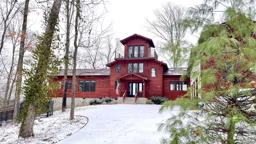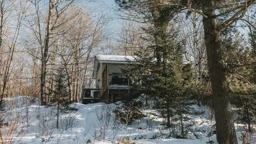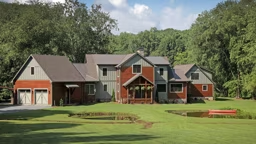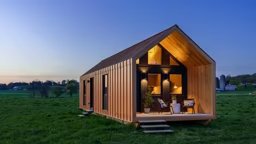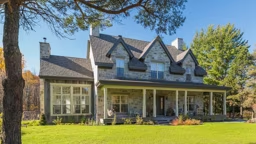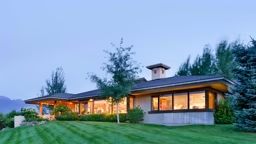Durable floor
Inside, one of the low-maintenance features is immediately visible underfoot. The main floor is a concrete slab that has been stamped and stained with a Mexican-style tile pattern that reflects the owner’s heritage. Not only is it eye-catching, but the concrete is durable and the upkeep simple. The slab also has energy-efficient in-floor radiant heat, which keeps the floor and the rooms warm and cozy through the long New Hampshire winters.
Solar benefits
The cottage’s positioning on the property takes advantage of the sun: The south-facing side has numerous windows and skylights to take advantage of passive solar energy in the winter; in the summer, mature deciduous trees shade that side of the cottage. The north side has a minimum of windows.
Throughout, the solid vinyl windows have Low-E glass.
No maintenance
The cottage has virtually no exterior maintenance. The choice of SIPs, energy-efficient windows, shingles and weathering stain applied to the siding creates a superior building envelope.
Pre-stained classic cedar shingles will achieve a blue-gray, weathered look with age. And the asphalt roof shingles are rated to last 35 years.
The only thing the owners will need to do is repaint the trim in about 15 years. Until then, they can just relax.
Inside, one of the low-maintenance features is immediately visible underfoot. The main floor is a concrete slab that has been stamped and stained with a Mexican-style tile pattern that reflects the owner’s heritage. Not only is it eye-catching, but the concrete is durable and the upkeep simple. The slab also has energy-efficient in-floor radiant heat, which keeps the floor and the rooms warm and cozy through the long New Hampshire winters.
Solar benefits
The cottage’s positioning on the property takes advantage of the sun: The south-facing side has numerous windows and skylights to take advantage of passive solar energy in the winter; in the summer, mature deciduous trees shade that side of the cottage. The north side has a minimum of windows.
Throughout, the solid vinyl windows have Low-E glass.
No maintenance
The cottage has virtually no exterior maintenance. The choice of SIPs, energy-efficient windows, shingles and weathering stain applied to the siding creates a superior building envelope.
Pre-stained classic cedar shingles will achieve a blue-gray, weathered look with age. And the asphalt roof shingles are rated to last 35 years.
The only thing the owners will need to do is repaint the trim in about 15 years. Until then, they can just relax.
Tucked away in the wooded hills of southern New Hampshire, Ashuelot Pond gleams like a sapphire. Located less than an hour’s drive west of Manchester and Concord, the owners thought the pond was a perfect setting for their vacation home.
They wanted a four-season getaway that could be passed down to future generations – plus it had to be easy to maintain and tough enough for New Hampshire’s snowy winters. They replaced an existing cottage with this energy-efficient model – a plus in these energy-conscious times.
Here are some of the low-maintenance and energy-efficient highlights of the cottage:
SIP Construction
The timber frame cottage was wrapped in structural insulated panels, or SIPs. The SIPs replace standard 2x4 or 2x6 studs and batt insulation used in traditional stick-frame construction. The panels consist of structural boards sandwiching a rigid foam core insulation, locking together to form a continuous insulating wall.
In this cottage, the walls were built with 41/2-inch-wide panels, while the roof used 51/2-inch panels. Since the panels are created in a factory and simply raised into position on-site, construction time is cut drastically.
According to the U.S. Department of Energy, SIPs offer energy savings of 12-14 percent compared to more traditional construction methods such as stick frame. When installed properly, SIPs also provide a more airtight dwelling, which makes a house more comfortable and quieter – not to mention more energy-efficient.
They wanted a four-season getaway that could be passed down to future generations – plus it had to be easy to maintain and tough enough for New Hampshire’s snowy winters. They replaced an existing cottage with this energy-efficient model – a plus in these energy-conscious times.
Here are some of the low-maintenance and energy-efficient highlights of the cottage:
SIP Construction
The timber frame cottage was wrapped in structural insulated panels, or SIPs. The SIPs replace standard 2x4 or 2x6 studs and batt insulation used in traditional stick-frame construction. The panels consist of structural boards sandwiching a rigid foam core insulation, locking together to form a continuous insulating wall.
In this cottage, the walls were built with 41/2-inch-wide panels, while the roof used 51/2-inch panels. Since the panels are created in a factory and simply raised into position on-site, construction time is cut drastically.
According to the U.S. Department of Energy, SIPs offer energy savings of 12-14 percent compared to more traditional construction methods such as stick frame. When installed properly, SIPs also provide a more airtight dwelling, which makes a house more comfortable and quieter – not to mention more energy-efficient.





